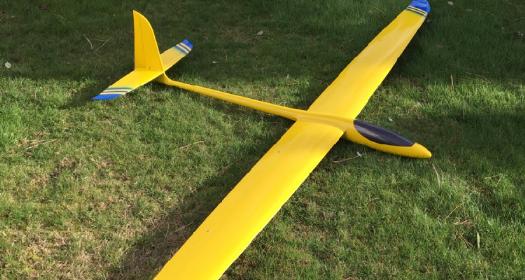|
X-Models X-Calibur |
||
Delayed Reaction? Fast forward twenty years or so, and I find myself with more electric powered models than I can sensibly fly in a year, an aged fleet of slopers, some of which date back to the 1980s and an increasing sensitivity to balsa dust which is taking much of the pleasure out of traditional building. So, looking arouind for something to refresh the sloping collection involving enough building work to keep me busy for at least a bit of the winter without getting dust up my nose, I at last found myself contemplating the plastic option. Selection So, having clarified my thoughts a bit, I consulted fellow flyers and received a number of useful recommendations. Unfortunately, following these up, I found that stock levels in the UK were not great, many models only being available to special order. However when I contacted Pete at South Coast Sailplanes about the X-Calibur, and found that he had one in stock, I decided to look no further. The bonus was that, SCS being a local supplier, I was able to go along and have a look at the model, pay the money and bring it home - no delays, no risk of transit damage. Inspection That said, the overall quality of the main parts seemed pretty good to my inexperienced eye, although the paint layer on the upper surface of the wings is a bit thin and streaky. The fittings supplied are of good quality, but exactly what is and is not supplied seems a little random. For example 2mm closed loop fittings are supplied but no wire or ferrules are included. No servo tray or fin post is provided but happily wing servo covers are - although mine were the wrong colour and had to be replaced. I was a bit surprised to see that the top and bottom colours of the wing didn't meet on the leading edge, leaving a white line (see photo). However, I'm told this is quite common with the manufacturing methods employed. Certainly the leading edge profile feels perfectly smooth so it's only a cosmetic blemish. When researching this model, one online reviewer raved about the excellent quality of the English instructions, so I was a bit taken aback to find that the link on SCS's website took me to an Italian version. Having failed to find the English version online, I e-mailed Pete at SCS asking for a pointer but got no response. I did though find English instructions for some of the more recent models in the X-models range, in particular the Sword so, with the aid of these and some Google translations of selected bits of the Italian, I was able to muddle through. Some bits of the Google translation were though more entertaining than helpful. For example, I was perplexed (and slightly perturbed) by "insert a "CERD" hinge in the first cut and continue inserting the "PTDR" pin in - thus castrating the zip"! Tail I managed to avoid the trap of setting up the tailplane at right angles to the fin and instead temporarily fitted the wings and lined it up with them. There is a slight twist in the fuselage so the fin isn't quite upright but this is far less noticeable than a cockeyed tailplane. |
||
|
||||||||||||||||||||||||||||||||||||||
